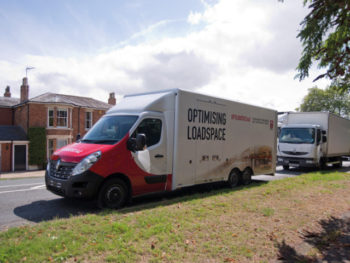Renault Trucks has developed a 6×2 Master, providing an alternative to the default 7.5-tonne truck, says Dan Gilkes.

Developments in vehicle technology have seen chassis weights rise, putting pressure on payloads. This is particularly true in the important 3.5-tonne sector, where many vans struggle to carry much more than one-tonne. The usual option is to move up to a 7.5-tonne truck, through here too payloads are under pressure.
There are several companies offering vans at 4.5 or 5.0-tonnes GVW, while Iveco will sell you a Daily at 7.2-tonnes. Now Renault Trucks has developed a slightly different option, by stretching the Master chassis to a 6×2 configuration. The vehicle’s gross weight is 6.0-tonnes, allowing for a payload of at least 3.0-tonnes and for bodies with up to 30m3 of load volume.
Proven Build
The conversion is carried out by Dutch chassis specialist Nefra Vehicle Technology, which builds the
low-floor chassis in both standard and wide track versions. The Master 6×2 is available with either steel or air rear suspension, with the majority of European buyers opting for air. The vehicle is based on a front-wheel drive chassis, allowing a low floor at the back and comes powered by Renault twin-turbo 165bhp diesel engine, driving through a six-speed manual gearbox.
When compared with a 7.5-tonne box truck, such as Renault’s own Midlum, both offer payloads of around 3.0-tonnes when equipped with a 30m3 box body and a tail lift. Indeed, the body dimensions are very similar, the Master’s is just considerably lower to the ground. Not only does that make it easier to access, but it reduces the danger of falls from height for the driver. Many operators could do without a tail lift, but the customer that has ordered the first vehicle needs to carry heavy loads that require a pump pallet truck to move, making it an essential requirement.
However, opening the Master, operating the lift and closing the rear door takes around 40 seconds. On the 7.5-tonne truck, it took closer to two minutes to carry out the same operation, resulting in a considerable operational efficiency gain for a multi-drop business. Plus, the Master body, built by UK specialist PD Stevens, also comes with a side loading door, making it easy for the driver to access the rear for small parcel delivery without using a lift at all.
Big Savings
The biggest benefit of the van versus the truck however, comes at the fuel pumps. We took both vehicles on a route through the Cotswolds, each part loaded with around 1.0-tonne of payload plus the driver. While the 7.5-tonne truck returned a reasonable 17.54mpg, the Master recorded a far more wallet-friendly 27.03mpg. Over a 30,000-mile year, with a gallon of diesel currently around £5.85, that results in a saving of more than 600 gallons, or £3,516. Over a five-year life span, that’s more than £17,500. Added to that, the repair and maintenance costs of the Master will be considerably lower than those of the truck, with components such as tyres much less expensive.
There is also a potential benefit in terms of customer acceptance. In the home delivery market in particular, a van-shaped vehicle is seen as far less threatening than a truck in a residential area. Not that the Master 6×2 is limited to home delivery. Renault Trucks is already talking to potential customers about horse boxes, car carriers and traffic management and cone distribution light commercial vehicles.
The 6×2 Master is not expected to become a major seller, but for those customers that need the additional carrying capacity, both in terms of loadspace and payload, it offers an option that is worth consideration.
At the Wheel
It’s not just the rear of the vehicle that is easier to access with the Master van. Any driver getting in and out multiple times a day will appreciate the ease with which they can get into the Master’s driving seat. Inside its standard Renault fare, though with the addition of a digital tachograph in the headliner above the windscreen.
At almost 8m long you do have to remember the extra length when maneuvering, but the 6×2 is otherwise much like any other Master to drive. On the move it feels no longer than an L3 or L4 wheelbase van and you just have to give the rear axles a little more room when turning to avoid kerbs. Renault had installed a rear-view camera to make it easier to park.
We tried a wide-track model with steel suspension, which was fine in town or at speed on a dual carriageway. However, if your mileage includes plenty of country roads or inter-urban use, the air suspension would probably be money well spent, as it can be a bit bouncy, that or a suspended driver’s seat.
Admittedly we weren’t running at maximum load, but the twin-turbo engine delivered plenty of pulling power, making it easy to keep pace with traffic and to pull out onto roundabouts. Indeed, the only remarkable thing about the 6×2, was just how unremarkable it was to drive.

